story and photos by Kayte Deioma
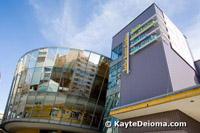 It’s rare to find a venue that can hold the attention of the younger kids in the family and the teenagers at the same time. The Zeum in San Francisco does this brilliantly and mom and dad can get in on the act too. Billed as a multimedia arts and technology museum, Zeum gets everyone’s creative juices flowing with opportunities to learn about video production and animation by creating your own productions from
It’s rare to find a venue that can hold the attention of the younger kids in the family and the teenagers at the same time. The Zeum in San Francisco does this brilliantly and mom and dad can get in on the act too. Billed as a multimedia arts and technology museum, Zeum gets everyone’s creative juices flowing with opportunities to learn about video production and animation by creating your own productions from 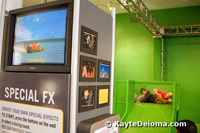 scratch using all the professional tools of the trade.
scratch using all the professional tools of the trade.
In the Main Gallery, you can get a quick idea how green backgrounds help create special effects in the Special FX area. After choosing an exciting video background like crashing waves or flames, you slide down a green sliding board and watch as the TV screen shows you sliding through the waves or the flames. This can keep little kids occupied for a good long time and give big kids a taste for creating a more elaborate production they can take home.
Video Production
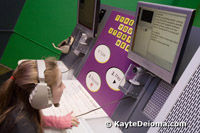 The rest of the Main Gallery has the components of a live Video Production on one side of the room and basic elements of animation on the other side. To produce a short video you can pick your own starting point. Some people like to get right to the heart of the
The rest of the Main Gallery has the components of a live Video Production on one side of the room and basic elements of animation on the other side. To produce a short video you can pick your own starting point. Some people like to get right to the heart of the 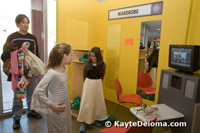 matter by typing a script into the teleprompter, so they know what kind of costumes to look for when they head to wardrobe. Others like to start in the wardrobe department to see what characters they can create and then write them a suitable storyline. There are costumes for young children up to adults, so the whole family can get involved. If you’d like to make a horror film, you can settle into the mask-making department and create your own masks.
matter by typing a script into the teleprompter, so they know what kind of costumes to look for when they head to wardrobe. Others like to start in the wardrobe department to see what characters they can create and then write them a suitable storyline. There are costumes for young children up to adults, so the whole family can get involved. If you’d like to make a horror film, you can settle into the mask-making department and create your own masks.
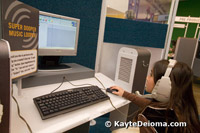 No film is complete without its musical soundtrack. You can compose yours in the Sound Lab. You don’t have to be working on a video project to use the Sound Lab. You can also use it to compose a song to perform, or to take home with you.
No film is complete without its musical soundtrack. You can compose yours in the Sound Lab. You don’t have to be working on a video project to use the Sound Lab. You can also use it to compose a song to perform, or to take home with you.
Once you have your story, wardrobe and soundtrack, you’re ready to choose your background and act out your script on the green background. If there are enough of you, someone can operate the camera and choose the camera angles 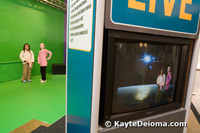 at the Tech Table; otherwise the staff technician will do that for you. For a small donation, your video production will be saved onto a DVD for you to take home.
at the Tech Table; otherwise the staff technician will do that for you. For a small donation, your video production will be saved onto a DVD for you to take home.
As you can imagine, creating all those elements can take a while, so you could divide up the tasks and have one person writing the script while another works on the music. Technical advisors are always around with suggestions to get you started.
Animation Stations
On the other side of the Main Gallery are several Animation Stations where you can create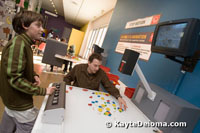 simple animations by moving objects around on a white table and taking photos of them with a camera mounted above or in front of the table. Another station is stocked with plastic dinosaurs and other creatures that you can use to create an animation. All of these animation
simple animations by moving objects around on a white table and taking photos of them with a camera mounted above or in front of the table. Another station is stocked with plastic dinosaurs and other creatures that you can use to create an animation. All of these animation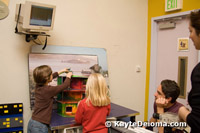 projects follow the same principle of using a series of still photographs of objects in different positions to create the impression of motion.
projects follow the same principle of using a series of still photographs of objects in different positions to create the impression of motion.
Next door in the Animators Studioyou learn about clay animation. Here again you have an opportunity to create a storyline, choose a pre-constructed set and create your own clay figures to shoot with stop-action video and a computer. You can take the clay figures and the animation DVD you create home with you.
The MetaField Maze
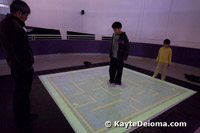 You could spend all day and never leave the primary production areas downstairs, but there’s more to do upstairs. The stairway circles around the Roundabout, where you’ll find the MetaField Maze, a virtual board game projected on the floor. You use your weight to tip the virtual play board and move a marble of light around the maze without letting it fall into a black hole. Tip: It helps to read the directions.
You could spend all day and never leave the primary production areas downstairs, but there’s more to do upstairs. The stairway circles around the Roundabout, where you’ll find the MetaField Maze, a virtual board game projected on the floor. You use your weight to tip the virtual play board and move a marble of light around the maze without letting it fall into a black hole. Tip: It helps to read the directions.
Upstairs
Upstairs you’ll find the Music Production Lab, where you can sing along karaoke-style to your favorite songs 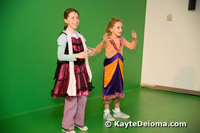 from Twinkle Twinkle Little Star to pop favorites. Again you can don costumes, choose your digital background and take your music video home with you.
from Twinkle Twinkle Little Star to pop favorites. Again you can don costumes, choose your digital background and take your music video home with you.
The Digital Studio, where you can learn about photo 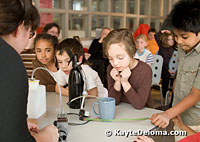 manipulation, was closed on our visit, but a Build a ‘Bot Workshop was going on in the classroom next door. Artist and robot inventor Simone Davalos demonstrated how to build a robot that would mix syrup and carbonated water to make soda. Kids and adults were fascinated with her demonstration of computer programming using the process of making a peanut butter sandwich to illustrate how to give a robot instructions.
manipulation, was closed on our visit, but a Build a ‘Bot Workshop was going on in the classroom next door. Artist and robot inventor Simone Davalos demonstrated how to build a robot that would mix syrup and carbonated water to make soda. Kids and adults were fascinated with her demonstration of computer programming using the process of making a peanut butter sandwich to illustrate how to give a robot instructions.
Outside
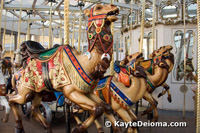 The 100-year-old Zeum Carousel, built in 1906 spent time in Seattle, New Mexico and 15 years in Long Beach, CA before returning to San Francisco in 1998. Its giraffes, camels, goats and horses have all been meticulously restored and look like new. One ticket will get you two rides on the merry-go-round.
The 100-year-old Zeum Carousel, built in 1906 spent time in Seattle, New Mexico and 15 years in Long Beach, CA before returning to San Francisco in 1998. Its giraffes, camels, goats and horses have all been meticulously restored and look like new. One ticket will get you two rides on the merry-go-round.
Outside the main Zeum tower, the Gift Shop offers an interesting variety of creative toys, games and books. The Zeum Café has snacks to feed the budding creative genius. If you’re looking for more of a selection, there are a few other fast food places nearby.
Zeum
221 Fourth Street
(at Howard Street next to the Moscone Center)
San Francisco, CA 94103
(415)820-3320
www.zeum.org

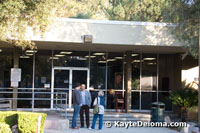 just occasionally look up at the moon and the stars, a tour of the Jet Propulsion Laboratory (JPL) in Pasadena will give you a new perspective on the night sky. It’s not something you can decide to do at the last minute on a rainy day because you have to make reservations in advance, so don’t wait for the rain to make your plans. If it does rain, you’ll need your umbrella for walking between the buildings.
just occasionally look up at the moon and the stars, a tour of the Jet Propulsion Laboratory (JPL) in Pasadena will give you a new perspective on the night sky. It’s not something you can decide to do at the last minute on a rainy day because you have to make reservations in advance, so don’t wait for the rain to make your plans. If it does rain, you’ll need your umbrella for walking between the buildings.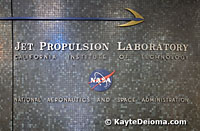 In the 1930s, a group of students at the California Institute of Technology (Caltech) were experimenting with rocket propulsion. After the explosions and the smell got them banned from campus, they found a spot a few miles away in a dry river bed at the foot of the San Gabriel Mountains to set off their rockets, and the Jet Propulsion Laboratory was born. The growing success of their rocket experiments brought in government funding and contracts with the U.S. Army.
In the 1930s, a group of students at the California Institute of Technology (Caltech) were experimenting with rocket propulsion. After the explosions and the smell got them banned from campus, they found a spot a few miles away in a dry river bed at the foot of the San Gabriel Mountains to set off their rockets, and the Jet Propulsion Laboratory was born. The growing success of their rocket experiments brought in government funding and contracts with the U.S. Army.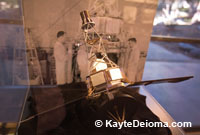 In January 1958, following on the heels of Russia’s Sputnik satellite launch, JPL created the first U.S. satellite to be sent into space, the Explorer I. When the National Aeronautics and Space Administration (NASA) was formed later that year, JPL was invited to be the lead research and development arm for NASA robotics. Since then, JPL has sent over 50 space exploration robots out into our solar system and currently has 17 research modules from satellites to the Mars Exploration Rovers, sending back signals to scientists on the ground. The oldest of these, the Voyager 1 and 2 have been in space since their 1977 launch and continue to send back signals from the far reaches of the universe.
In January 1958, following on the heels of Russia’s Sputnik satellite launch, JPL created the first U.S. satellite to be sent into space, the Explorer I. When the National Aeronautics and Space Administration (NASA) was formed later that year, JPL was invited to be the lead research and development arm for NASA robotics. Since then, JPL has sent over 50 space exploration robots out into our solar system and currently has 17 research modules from satellites to the Mars Exploration Rovers, sending back signals to scientists on the ground. The oldest of these, the Voyager 1 and 2 have been in space since their 1977 launch and continue to send back signals from the far reaches of the universe.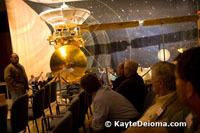 small theater with large scale models of some of the more famous space exploration robots on display. The guide gives a brief history of JPL before showing a short film that gives a refresher course on the solar system and some of the highlights of what the research vessels have found. Exciting footage puts you in the control room with JPL scientists and engineers as the Mars Rover lands successfully on the red planet.
small theater with large scale models of some of the more famous space exploration robots on display. The guide gives a brief history of JPL before showing a short film that gives a refresher course on the solar system and some of the highlights of what the research vessels have found. Exciting footage puts you in the control room with JPL scientists and engineers as the Mars Rover lands successfully on the red planet.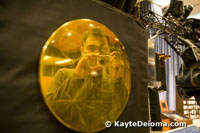 Voyager, with its golden record on the front, conceived by Carl Sagan. You can also hear a piece of the recording which contains greetings in 60 languages, bits of music and other cultural sounds of the 70s, and see the 117 pictures that were chosen to represent humanity on earth. In case there is intelligent life out there somewhere, pictographic instructions are etched on the record cover describing how to play it. Other models on display include the Mars Global Surveyor, the Mars Odyssey Orbiter, and the Cassini Spacecraft andHuygens Probe, currently circling Saturn and its moon, Titan.
Voyager, with its golden record on the front, conceived by Carl Sagan. You can also hear a piece of the recording which contains greetings in 60 languages, bits of music and other cultural sounds of the 70s, and see the 117 pictures that were chosen to represent humanity on earth. In case there is intelligent life out there somewhere, pictographic instructions are etched on the record cover describing how to play it. Other models on display include the Mars Global Surveyor, the Mars Odyssey Orbiter, and the Cassini Spacecraft andHuygens Probe, currently circling Saturn and its moon, Titan.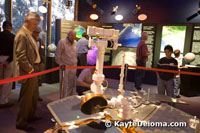 Next to the theater is the JPL Museum. A full scale Mars Exploration Rover and many smaller scale models of spacecraft are on display. Globes of planets and moons indicate named features that have been documented by the space explorers. While older members of our group honed in on trying to find their houses on a large satellite map of Southern California, James, who looked to be about 5, raced from model to globe to model calling to his friend, “Thunder, you gotta see this!”
Next to the theater is the JPL Museum. A full scale Mars Exploration Rover and many smaller scale models of spacecraft are on display. Globes of planets and moons indicate named features that have been documented by the space explorers. While older members of our group honed in on trying to find their houses on a large satellite map of Southern California, James, who looked to be about 5, raced from model to globe to model calling to his friend, “Thunder, you gotta see this!”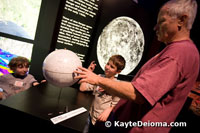 Large scale photos of the birth and death of stars, taken from the Hubble Space Telescope, adorn one wall. A sample of Silica Aerogel, also known as “solid blue smoke” has a certificate from the Guinness Book of World Records for being the lightest solid substance in the world. In the next museum display, they project a neat little light show on blocks of the smoky substance. In space, among other things, they use it to capture particle samples.
Large scale photos of the birth and death of stars, taken from the Hubble Space Telescope, adorn one wall. A sample of Silica Aerogel, also known as “solid blue smoke” has a certificate from the Guinness Book of World Records for being the lightest solid substance in the world. In the next museum display, they project a neat little light show on blocks of the smoky substance. In space, among other things, they use it to capture particle samples.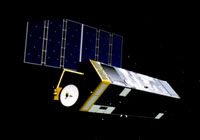 From the video, you know that this nerve center of operations is filled with wall to wall scientists and engineers when it’s time for a launch or landing. It looks a lot like other NASA control rooms you see in the news and the movies for the launch of manned space missions. On an ordinary day, most of the three rows of consoles in the main room and more work stations in a windowed area off to the side are unoccupied. On our visit, five people are at their monitors, keeping track of all the unmanned spacecraft in the universe.
From the video, you know that this nerve center of operations is filled with wall to wall scientists and engineers when it’s time for a launch or landing. It looks a lot like other NASA control rooms you see in the news and the movies for the launch of manned space missions. On an ordinary day, most of the three rows of consoles in the main room and more work stations in a windowed area off to the side are unoccupied. On our visit, five people are at their monitors, keeping track of all the unmanned spacecraft in the universe.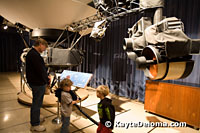 Using flat planets stuck on a carpet wall, we get a lesson in space distances. The comparison that most resonates with me is the time it takes to send and receive messages. It takes 1.5 seconds for a message to reach the moon, which is a mere 384,000 miles from Earth. It takes over 14 hours for a message to travel to the Voyager 1 spacecraft. At 10 billion miles from Earth and counting, it is the most distant human creation in the universe. Traveling at about 39,000 miles per hour, Voyager 1 should reach the outer boundary of our solar system within the next 10 years. Hopefully its 1977 nuclear batteries will still be running to tell us what’s out there.
Using flat planets stuck on a carpet wall, we get a lesson in space distances. The comparison that most resonates with me is the time it takes to send and receive messages. It takes 1.5 seconds for a message to reach the moon, which is a mere 384,000 miles from Earth. It takes over 14 hours for a message to travel to the Voyager 1 spacecraft. At 10 billion miles from Earth and counting, it is the most distant human creation in the universe. Traveling at about 39,000 miles per hour, Voyager 1 should reach the outer boundary of our solar system within the next 10 years. Hopefully its 1977 nuclear batteries will still be running to tell us what’s out there.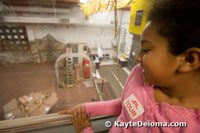 glassed-in walkway you can look down on a Mars simulation room where a replica of the Mars Rover is used to test out program directions before they are sent to the Rovers on Mars. If there is a problem with the Spirit or Opportunity Rovers, the problem is recreated and solved with the replica Rover and then the solution is uploaded to the research vehicles on Mars. It takes about 15 minutes to send a signal to Mars – a lot closer than the Voyager 1.
glassed-in walkway you can look down on a Mars simulation room where a replica of the Mars Rover is used to test out program directions before they are sent to the Rovers on Mars. If there is a problem with the Spirit or Opportunity Rovers, the problem is recreated and solved with the replica Rover and then the solution is uploaded to the research vehicles on Mars. It takes about 15 minutes to send a signal to Mars – a lot closer than the Voyager 1.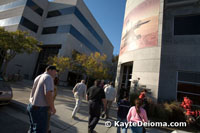 f you’re traveling with a group of 10 or more, special tours can be arranged outside of the Wednesday public tours. JPL also holds an annual two-dayOpen House in May where the scientists come out of their labs and bring their projects to demonstrate, from Mars Exploration Rovers and other robots to thermal imaging equipment, solar telescopes and space suits. There are also monthly lectures on space and technology-related topics that are open to the public.
f you’re traveling with a group of 10 or more, special tours can be arranged outside of the Wednesday public tours. JPL also holds an annual two-dayOpen House in May where the scientists come out of their labs and bring their projects to demonstrate, from Mars Exploration Rovers and other robots to thermal imaging equipment, solar telescopes and space suits. There are also monthly lectures on space and technology-related topics that are open to the public.